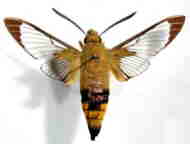 SKC Films Library SKC Films Library |
| SKC Films Library >> Science >> Zoology >> Insects >> Order Lepidoptera |
| Family Sphingidae (Hawk Moths, Sphinx Moths) Description Hawk moths range in size from 1-1/2 to 6 inches in length. They are easily identified by their stout bodies, obvious head, and large eyes. The forewings are typically long and narrow, and much larger than the hind wings. The abdomen is large, with a tapered cigar-shape appearance. Most sphinx moths are brownish, often marked with a bright color. Bee-Hawk Hawk moths have the longest tongues of all lepidopterans, up to 14 inches long in many species. Distribution and Habitat There are about 850 species of hawk moths worldwide, with the highest diversity being in wet tropical regions. They are common in woodlands, meadows, and gardens. Reproduction Eggs are laid singly on the underside of the larval food plant, with up to 100 or more eggs being laid per season. A sphinx moth caterpillar can usually be identified by the "horn" at the rear of the body. Some caterpillars have lateral stripes and/or large eye spots on the thorax and abdominal segments. Hawk Moth Caterpillar When ready to pupate, the caterpillar will move down into the leaf litter and make a rough open cocoon or cell on soil surface. The pupal stage lasts 1-25 weeks. Adult sphinx moths live several weeks, during which time they feed often, breed, and lay eggs. Scientific Classification phylum Arthropoda |
| SKC Films Library >> Science >> Zoology >> Insects >> Order Lepidoptera This page was last updated on June 15, 2017. |

